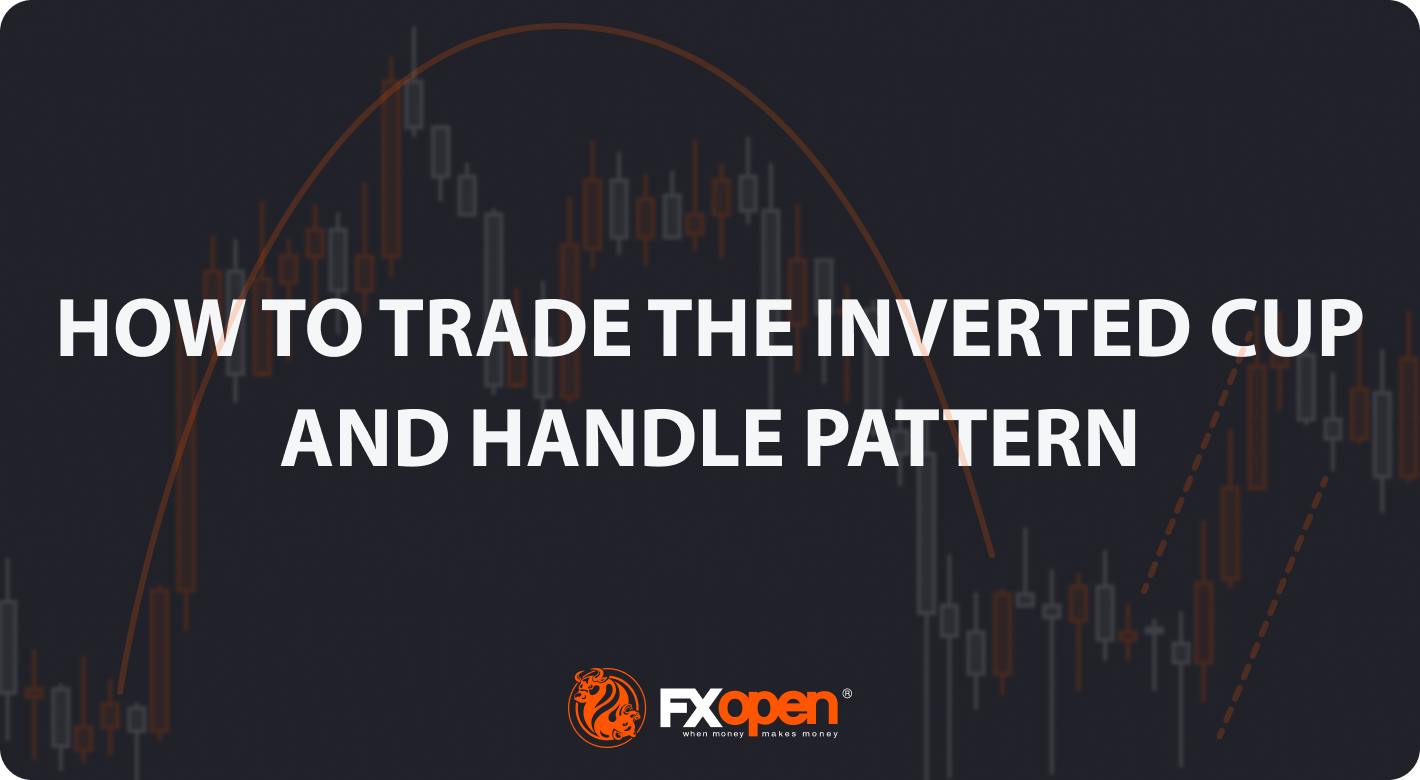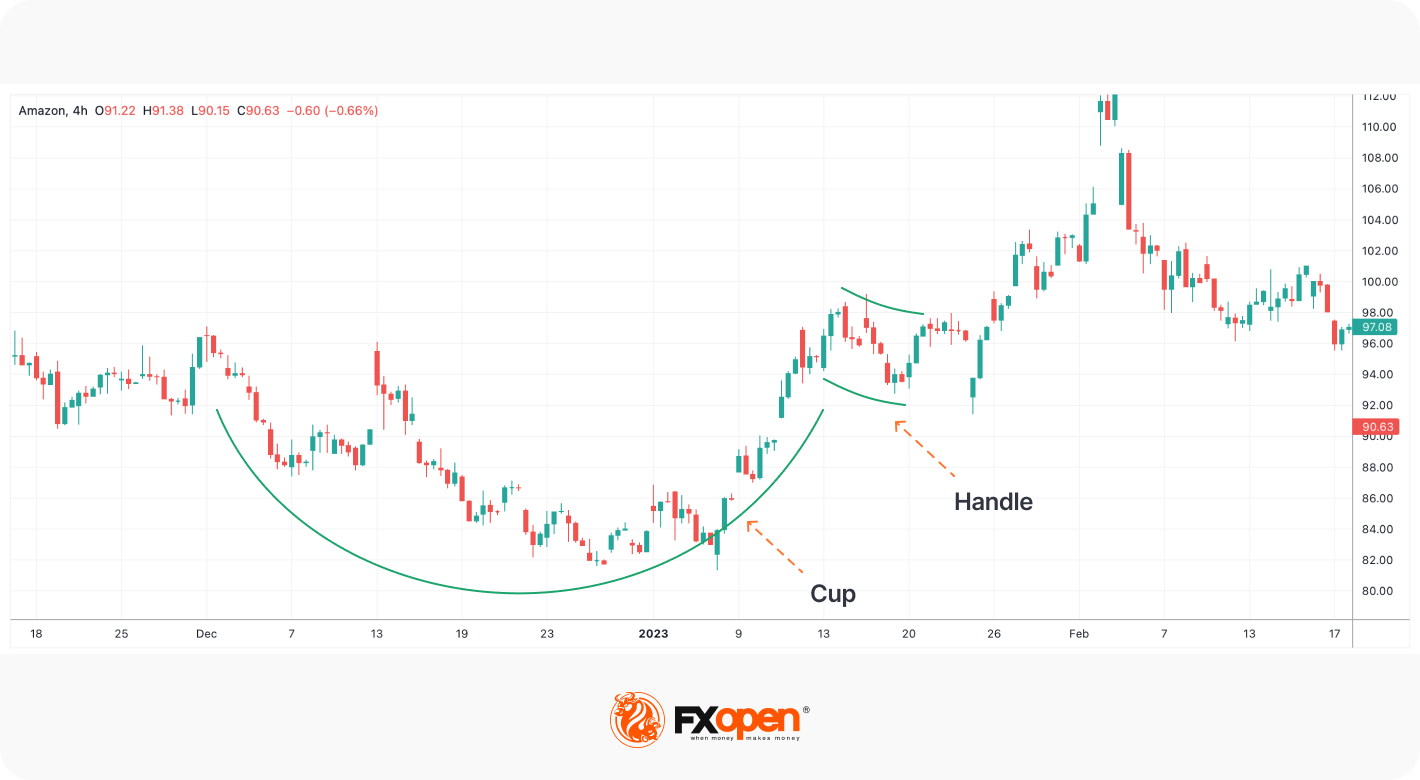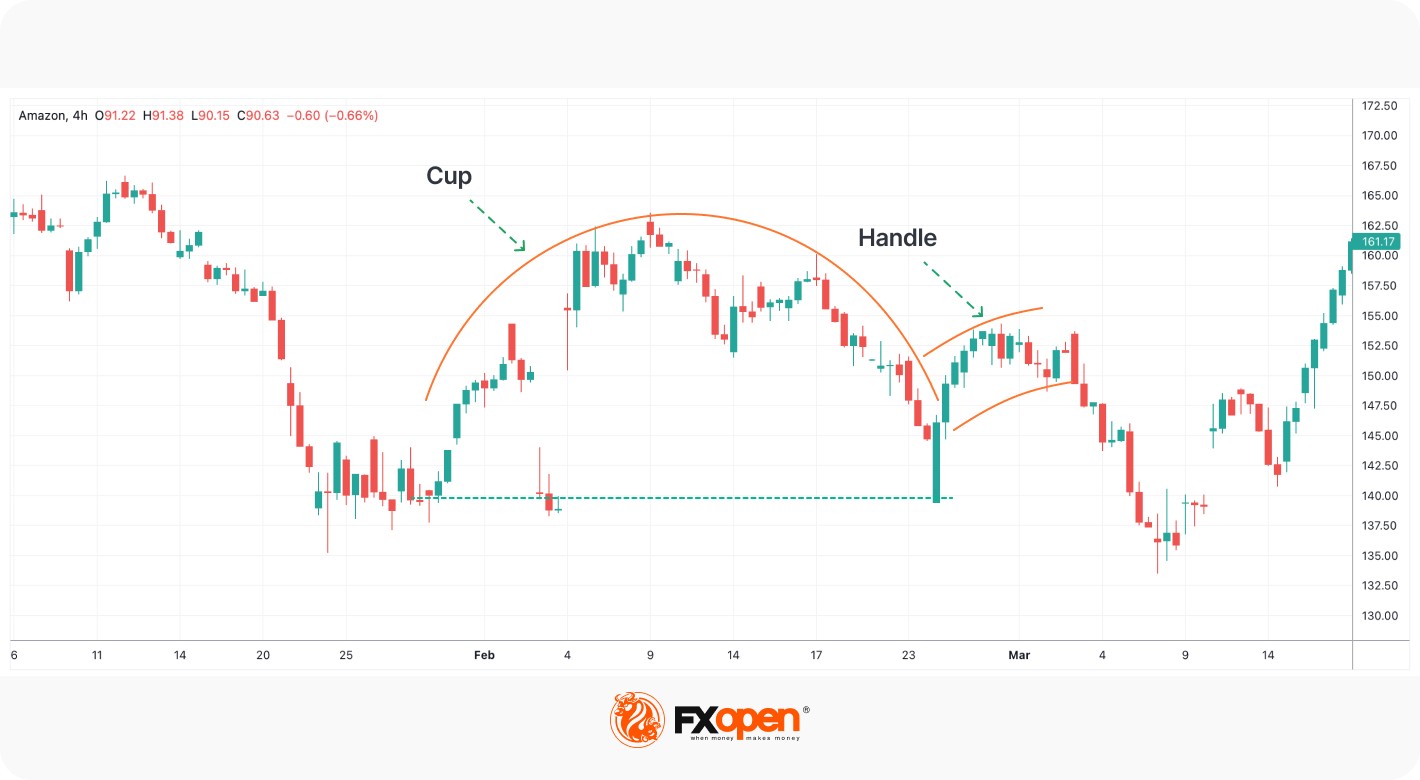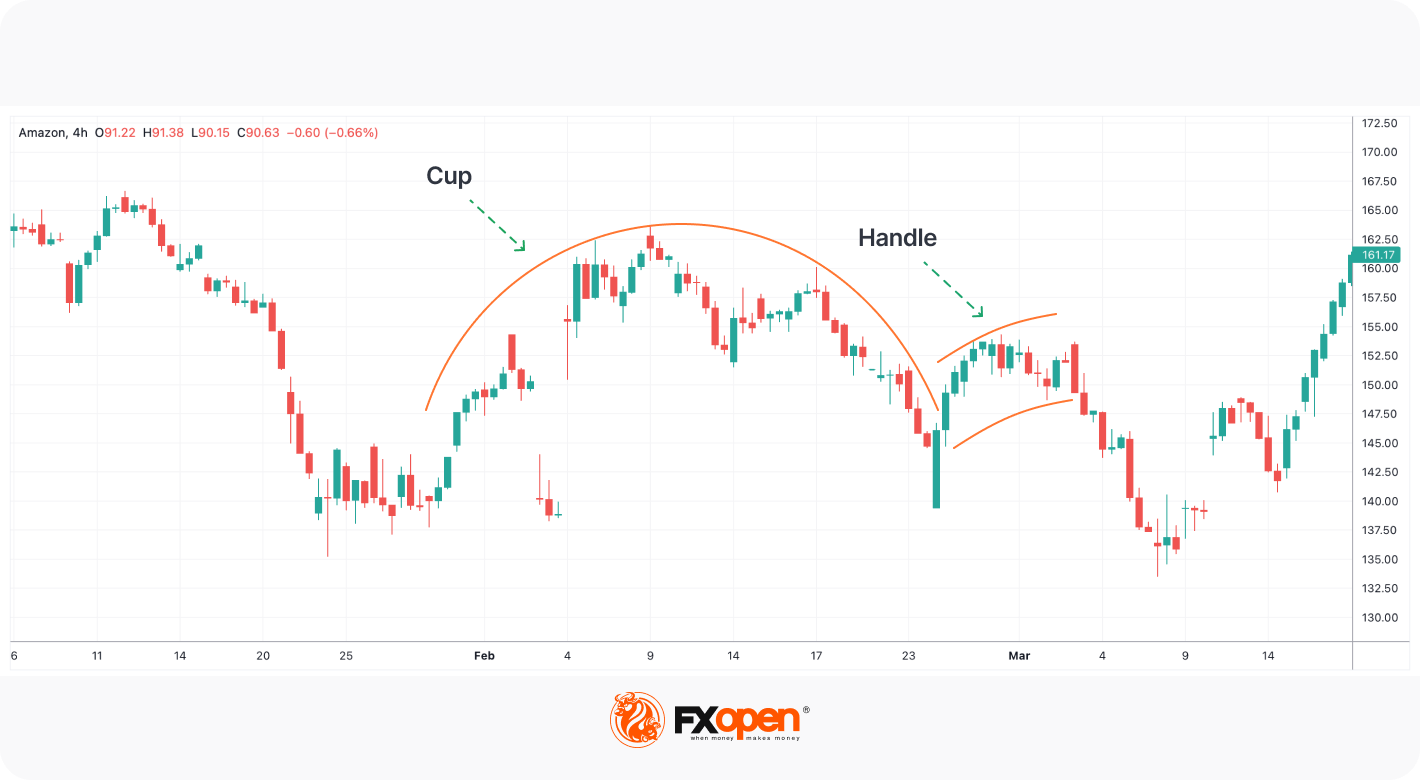FXOpen

The use of chart patterns to analyse financial markets has been around since the inception of technical analysis. With the advancements in the fintech sector in the 20th century, chart patterns gained even further popularity amongst market participants.
The inverted cup and handle is a reliable chart pattern in the forex and other financial markets. In this FXOpen guide, we will provide a definition of the inverted cup and handle pattern and its trading rules.
What Is an Inverted Cup and Handle Pattern?
American technician William J. O'Neil introduced the cup and handle pattern in his book How to Make Money in Stocks. He distributed the user manual through multiple articles published later on in his newspaper, Investor's Business Daily.
This pattern comes in two types – traditional and inverse. A common question is whether there is any difference between them. A traditional cup and handle pattern is an indicator of a bullish continuation. The inverted cup and handle pattern’s meaning is obvious from its name and functionality. In contrast with a traditional cup and handle pattern, an inverted cup and handle is an indication of a bearish movement.
Note: Both patterns can act as reversal patterns, but continuation is more likely.
Traditional Cup and Handle Pattern

AMZN stock price forms a cup and handle pattern on the H4 chart. As the pair faces resistance at 98.00, it pulls back to form a handle before finally breaking the resistance.
Inverse Cup and Handle Pattern
An inverted cup and handle stock pattern in the 4-hour AMZN chart shows a price continuation to the downside. The pair forms a cup with a peak of 162.50 and 145.00 as its support. The price retraces from the support to form a diagonal handle. As the selling pressure increases, the price finally rips through the support.

Continuation Pattern vs Reversal Pattern
As the name indicates, the continuation pattern highlights the continuation of the current bullish or bearish trend after a brief pause. A good example of such a pattern is the bullish/bearish rectangle or the bullish/bearish pennant.
Reversal patterns, on the other hand, indicate that the market may reverse its direction from the ongoing up or downtrend. Double tops or bottoms are some good examples of this.
How to Spot the Upside Down Cup and Handle Pattern
You can observe the inverse cup and handle pattern on various financial instruments on different timeframes. It consists of two parts:
- Cup. The cup takes the shape of an inverted U or V. A U-shaped cup may act as a better standard as it constructs a complete formation. The depth of the cup is uniform and smooth. The cup develops when the price moves up in a medium-paced rally, then goes into a small range, and finally falls back in the same fashion as it came up. The left half of the dome-shaped area may be considered profit-taking by bear market traders. The start and end points are almost at the same level, so a horizontal support line can be drawn through them.
- Handle. The market touches the initial support level of the cup and retraces to about 30-50% of the prior bullish move. The last effort of the bulls is finally overtaken by the bears, who push the price down and break the previous support. The pattern is complete when the price breaks below the lower level of the handle or the support level. For further confirmation, some traders wait for the candlestick to complete beneath the levels. The distance between the cup's peak and the support level can act as a potential take-profit target of the inverse cup and handle pattern.
The image below clarifies this:

Remember that the inverted cup and handle pattern will take longer to form on the higher timeframes, such as a daily or weekly chart, as each candle accounts for a full day or a week.
How to Use the Inverse Cup and Handle
The inverted cup and handle pattern screams a sell signal for traders. However, this does not mean that you should immediately take a short trade once the initial signs of the pattern start to appear on the chart. The highest probability is only displayed after the inverse cup and handle pattern is complete.
Combining the pattern with other technical indicators can help provide a further confirmation for the short position. The FXOpen TickTrader platform offers a fully customisable trading experience with advanced technical analysis tools to help you trade the inverse cup and handle with ease.
Strategy #1 - Moving Averages
The trend is your friend is a common proverb used by many experienced traders, highlighting the importance of market momentum. As the inverted cup and handle is an example of trend continuation, it can be coupled with trend indicators.
Moving averages, MACD and RSI, are some of the few general trend indicators. For our example, we will use simple moving averages.
If the price is above MA, the overall trend is bullish; if it is below MA, the trend moves downward. The moving average can also act as an indicator for support and resistance if necessary.

Can you spot the cup and handle pattern on the M30 chart for AUDCAD? The crossover between moving averages indicates a shift from the up to a downtrend. We also see a cup and handle pattern, providing more confluence on the short side. The entry is available as soon as the candlestick breaks the support with a stop loss above the handle. The take profit is the next support or the distance equal to the length between the cup’s peak and the support level.
Strategy #2 - Stochastic Divergence
Stochastic is a momentum indicator composed of two moving averages oscillating between 0 and 100. A value above 80 indicates that it is overbought, while one below 20 shows oversold conditions.
Stochastic divergence is a phenomenon where the market and the indicator display opposite highs and lows. For example, the price may set higher highs and lows while the stochastic forms lower highs and lows. The indicator may reflect that the current trend is reversing. This is useful for trading the inverted down cup and handle pattern in a bullish trend.
An example of hidden bearish divergence in the CHFJPY chart in which the price makes lower highs and the stochastic oscillator shows higher highs. The entry is available as the handle is formed, and the stochastic indicator leaves the overbought area.
Strategy #3 - Volumes
Volume was one of the key indicators used in institutional trading back in the 70s and 80s. It still maintains its importance in determining market sentiment. High or low volume can indicate an increase or decrease in market activity for a certain financial instrument. Remember that volume is a lagging indicator and may not always predict price movements accurately.
The 1-hour chart of CHFJPY forms an inverted cup and handle pattern. Excessive sell volume is present during the breakout, which confirms the bearish bias for the price. The stop loss hangs just above the handle. The exit is taken at the next support level or trailed as long as the downtrend continues.
Takeaway
The inverted cup and handle chart pattern features in the trading arsenal of many technical traders. The pattern may be hard to identify at first; however, it'll become easier to find after you trade it a few times. Market participants should not take it as a holy grail indicator, as the profitability of each strategy can vary heavily according to market conditions. Trading psychology can also greatly affect your overall gains. You can open an FXOpen account and try out the reverse cup and handle pattern with different sets of indicators in a live market.
This article represents the opinion of the Companies operating under the FXOpen brand only. It is not to be construed as an offer, solicitation, or recommendation with respect to products and services provided by the Companies operating under the FXOpen brand, nor is it to be considered financial advice.
Stay ahead of the market!
Subscribe now to our mailing list and receive the latest market news and insights delivered directly to your inbox.








